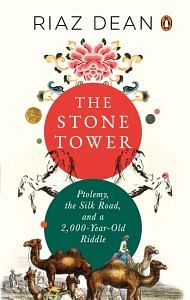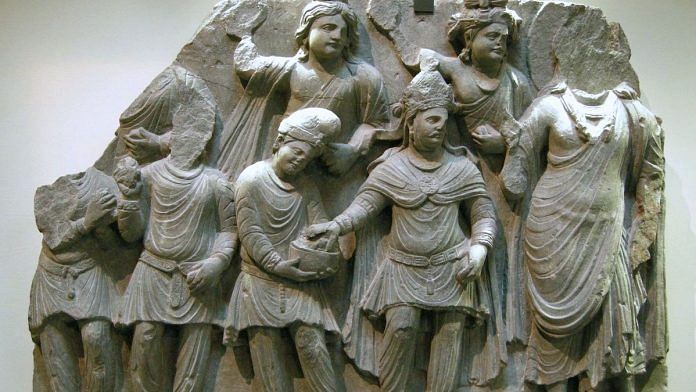The Kushans were one of two key middlemen during the First Silk Roads Era (the other being the Parthians). Moving goods between Rome and China, they would unify the overland Silk Road between the Oxus and Ganges rivers and establish themselves as cosmopolitan masters of northern India. Much of their prosperity also came from controlling the maritime trade between the Indian and Roman ports and, in doing so, they were able to circumvent the Parthians and their high taxes levied on caravans. In the main, the Kushans kept peace with their neighbours, creating the stable conditions crucial to promoting trade and cultural exchange. Their rule as a family dynasty would last over two centuries; and after their fourth king Kanishka came to power around ad 127, the subsequent so-called Great Kushans era has been described by Narain ‘as one of the great periods of world history’.
Yet in comparison to the other three Silk Road empires, frustratingly little is known about them from when the Yuezhi- Kushans first migrated into Bactria [Afghanistan region], as they did not produce any great historian nor possess a script of their own. Moreover, there is no consensus about their borders or chronology; Benjamin regards the Kushans as ‘one of the most important yet least known agrarian civilizations in world history’. Even the span of their rule—for our purposes ad 25 to 225—is one of the most disputed in Asian history.
Yuezhi-Kushans emerged as prime middlemen of the Silk Road, ready to cash in on the great entrepôt of increasing Eurasian trade. No doubt, they learnt a good deal about the art of trading from the wealthy Bactrians whom they had unseated. In their adopted homeland, the Yuezhi-Kushan presence was strong, comprising 100,000 households with a population four times that number.
Other than dominating northwestern India, the Kushan Empire expanded across the Oxus to include parts of Sogdiana and Kangju in their sphere of influence. The Hou Hanshu records noted that their ‘way of life is identical’ and the Kushans would cement their relationship with the people of Kangju through marriage into their ruling family. Historians find the northern boundary of the Kushan Empire vague and difficult to pin down, and whether it incorporated the southern sections of Sogdiana or Kangju is uncertain.
Unfortunately, the fragmentary documents and inscriptions discovered to date only go a little way towards piecing together Kushan history. Critical evidence comes from another source altogether, numismatics; and the many thousands of coins unearthed over the years bear testimony to their story. In fact, the legend on these coins represents the only other extant writing generated by the Kushans, thus making their study critical.
Also read: Tracing history of Ladakh’s dynamic borders — from Tibetan empire to Sikh rule to J&K state
Unlike most objects made from naturally occurring materials— such as wood, fabrics and leather—coins made from metal are obviously less likely to perish with time. Being mass produced, they also have a significantly higher rate of survival and therefore discovery. Even today, old coinage from as far away as Rome can be found in the bazaars of Asia, sometimes after being picked up by farmers while tilling their fields. Importantly, the script on these coins, although somewhat limited, provides hard evidence of the reign of past dynasties and their rulers. And since each monarch would typically issue new coinage upon assuming power, most can be readily dated.
Where these coins are found is also of importance. Areas across northern India and Central Asia in which Kushan coinage has been discovered help mark out the extent of the empire and the reach of their trading activity. Conversely, for example, the extreme rarity of finds in Sogdiana proper suggests that their northern neighbours had probably maintained their independence. Whereas a study by Cribb of Kushan coins found in Khotan provides further evidence of their direct economic and political control of this important Silk Road city.
The style of their coinage tells its own story. During the Yuezhi- Kushans migration into Central Asia and India, they encountered the Greeks and Romans whose influence is clearly visible on Kushan coins. For example, their strongman Hercules is depicted on the reverse side of some issues; while Kujula’s early portraits were clearly inspired by their emperors, reflecting the contact between Rome and India. His mint was largely based on Greek practices and copied styles from the regions he conquered. Although initially starting out with the simple yabghu title on his coinage, on achieving greater victories he began bestowing on himself grand titles such as Maharaja Rajarajasa Devaputra (Great King of Kings, Son of a Divine Being).
The Kushans would adopt Bactrian as their official script (using the Greek alphabet) and as one of their official languages, which they called Aryan. In fact, during this period, Bactrian was one of the world’s most important languages; and by inscribing their coinage with Greek letters, the Kushans ensured their currency was widely usable across the Silk Road. (Greek tradition would also have a profound and lasting effect on Kushan culture in many other ways.)
Kanishka expanded his nation’s territory to probably its greatest extent, heralding the start of the empire’s high point. His reign of some twenty-six years, beginning around ad 127, witnessed many caravans criss-crossing the Silk Road, and during this time Ptolemy would complete his Geographia (although he did not mention the Kushan Empire by name). When Kanishka took the throne he declared the start of a new era, which he signified by engraving his coins from ‘Year 1’.
Like the Mauryan emperor Ashoka the Great four centuries before him, Kanishka is also remembered as a great patron of Buddhism, leading to its proliferation throughout Asia. The same routes first taken into India by the nomadic tribes, the Saka and Yuezhi, served as pathways out for monks—hence, this route is sometimes referred to as the Buddhist Road.
Also read: Here’s how Xi Jinping wants China to build its own Silicon Valley
In Sanskrit literature, the Enlightened One is referred to as the Mahasarthavaha (Great Caravan Leader) for leading his followers to nirvana after having eliminated human suffering. A disciple of his, the Indo-Greek king Menander, in describing his lord to a converted Bactrian king, explained that Buddha ‘is like a caravan leader to men in that he brings them beyond the sandy desert of rebirths’. Kushan merchants were particularly attracted to his teachings and, perhaps surprisingly, its strong commercial philosophy, as historian Xinru Liu points out by quoting the advice offered in Dialogues of the Buddha:
Whoso is virtuous and intelligent,
Shines like fire that blazes [on the hill].
To him amassing wealth, like roving bee
Its honey gathering [and hurting naught], Riches mount up as an ant-heap growing high. When the good layman wealth has so amassed Able is he to benefit his clan.
In portions four let him divide that wealth.
So binds he to himself life’s friendly things.
One portion let him spend and taste the fruit. His business to conduct let him take two. And portion four let him reserve and hoard; So there’ll be wherewithal in times of need.
Such advice was consistent with Kushans positioning themselves as middlemen on the Silk Road, enabling them and their caravans to thrive; as Liu again notes: ‘For merchants, making donations was a much more satisfying and practical approach than self-denial.’ Together with many of the rich and powerful, they reciprocated by becoming great patrons of the religion, channelling some of their wealth into its monasteries and temples, adorning them with great artworks, silk and gems to make them seem like paradise. They also created images of the Buddha and had his sutras copied out in an effort to acquire the ‘merit’ needed to escape the cycle of suffering and rebirth.
Kanishka is regarded as the greatest of the Kushan kings. He would be followed by two others before the dynasty began its steady decline, sometime after ad 225—a story again reflected in their coinage, which begins to show deterioration and debasement. During most of the First Silk Roads Era, the Kushans were the great merchants of Central Asia, playing such a critical role that Benjamin suggests his designation of this period could also be labelled the Kushan Era. After their decline as middlemen, they would be replaced by another people: traders who had started out as their apprentices but whose time had now come—the Sogdians.
 This excerpt from Riaz Dean’s ‘The Stone Tower: Ptolemy, the Silk Road, and a 2,000-year-old Riddle’ has been published with permission from Penguin Random House India.
This excerpt from Riaz Dean’s ‘The Stone Tower: Ptolemy, the Silk Road, and a 2,000-year-old Riddle’ has been published with permission from Penguin Random House India.



